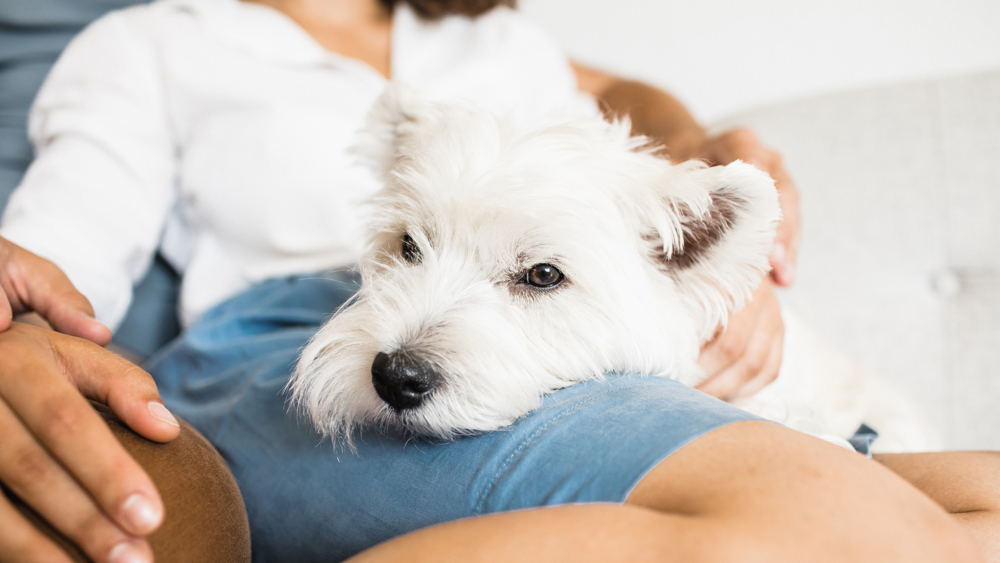
It may surprise you to learn that dogs can suffer from a type of depression. There are many factors that can impact on a dog’s emotional state, including changes to routine, environment, social group, or as a result of chronic stress or anxiety resulting from fears and phobias or lifestyle.
Signs of an unhappy dog
Withdrawn
The dog may have little enthusiasm for exercise or games or joining in with the things they normally enjoy.
Lethargic
They may be sleeping more than usual.
Loss of appetite
They may lose interest in food or there may be other changes to eating patterns.
Inability to settle
The dog may appear restless, not sleeping well or deeply, or other changes to sleeping patterns.
Behaviour changes
The same mood states that can present as apparent depression can present as other issues depending on the dog’s personality. These can include chewing, attempts at escapology, increased reactivity, loss of toilet training, and even aggression.
What causes ‘dog depression’?
There are many factors that can impact on a dog’s emotional state, including changes to routine, environment, social group, or as a result of chronic stress or anxiety resulting from fears and phobias or lifestyle. Some of these can produce what looks like a canine version of depression, but so often owners don’t recognise the change in their dog’s mood, or know that they can do some very simple things to transform their dog’s life.
Changes to environment
Most dogs like routine and are happiest when they are confident in their environment and know what to expect during their day. Dramatic changes, such as house moves, building work or major home reorganisations, can leave your dog feeling uncertain. In these instances you may well see changes in their personality or behaviour as they try to adjust and regain their routine and feelings of safety.
Changes to social group
A dog’s bond with its family is very strong and changes to their social dynamic can strongly affect them, such as divorce, bereavement (human, canine and sometimes even feline), children leaving home, or even a change in working patterns. Dogs don’t understand where their friends or loved ones have gone and of course we can’t explain it to them so that they understand.
It’s not just grief that can affect a dog’s mood however. If you are suddenly less available to your dog, such as returning to work after a break, or starting a new job – it can hit them hard. They rely on you totally for company, security and love, and can feel your increased absence keenly.
Boredom
It’s easy to only pay attention to dogs in the few short hours a day we are exercising them, but for many dogs that means upwards of 12 waking hours a day, every day, with absolutely nothing to do! For dogs, especially working types, boredom can lead to a number of different behavioural problems, including depression.
Fears and phobias
Often what looks like canine depression is a sign of an underlying behaviour issue. Even though they are not showing any acute or obvious signs of fear, a dog who suffers from noise phobias, or separation related issues, for example, can be in a chronic state of stress or anxiety, always waiting for the next bang or the next time they are left home alone.
Seasonal Affective Disorder (SAD)
Our dogs have certain hard-wired needs that we need to fulfil to keep them healthy and happy. A major one of these is exercise and physical and mental stimulation. Not only that but they need the right kind of exercise, and this can often be breed or type dependant.
Through the winter – especially the long, wet winters we have been seeing in recent years – it can be hard to give dogs the exercise they need. Dark mornings and evenings, and muddy, wet walks, can make taking the dog out seem like a chore. As a result, many dogs are getting less exercise or fewer walks than usual, and aren’t getting to do the things they truly love.
In other cases, owners don’t realise just how much exercise their dog needs, or what types of things will keep them happy. All dogs are different and so finding out what fulfils a dog’s hard-wired needs can be the key to a contented dog. It’s similar to someone who loves nothing more than doing yoga being forced to only do marathon running! Yes, you’d be getting the exercise you need, but you wouldn’t be enjoying it, and would probably be feeling pretty fed up about it!
A lack of being able to do the things they have been selectively bred to do, or just the things that they love, can result in a whole host of behaviour problems, some of which will present a lot like depression.
Physical illness or pain
Low mood states don’t only have mental and emotional causes at their root. Some physical conditions – especially those which cause pain – can affect a dog’s mood, and whenever there are sudden changes in a dog’s personality or behaviour the first step should be a visit to the vet to check there are no clinical causes.
Personality
Like us all dogs are different. Some are by nature bouncy and very obviously happy all the time, while others are more reserved and self-contained, but are no less contented. Know your own dog and do some research on what things they may enjoy to enhance their life and their mood, but also be aware of what their usual (resting) mood state is.
It ain't what you do, it's the way that you do it
All dogs should have some training so that they can have the freedom they need to be able to be let off the lead, where it is safe to do so, and so they are not a nuisance or danger to themselves or others. How you train your dog – and how you relate to them day-to-day – will have an impact on their mood.
Reward-based training methods and handling improve the bond between a dog and their owner. Heavy-handed methods that rely on punishment can however leave the dog feeling unable to succeed, resulting in a loss of confidence in their owner, and producing a state of learned helplessness. These dogs may appear quiet and well-behaved, but may actually be experiencing a very low mood state and chronic stress where it is far safer to do nothing.
What to do?
Recognising the problem is the first step to solving it, then do a canine mental health assessment on your dog.
- Has anything changed in your dog’s life, environment or social group?
- Is your dog getting as much exercise and stimulation as usual? Is your dog getting the right sort of exercise and stimulation to give them an outlet for their hard-wired needs and the things they love?
- Is your dog getting as much contact with you are usual?
- Are you spending enough quality time with your dog? This may be exercise, games, training, dog sports or just hanging out together.
- Is your dog bored? Can you relieve this with an additional walk, short training sessions throughout the day, occasional games, interactive toys etc?
- Does your dog have any other behaviour issues – especially fears and phobias that may be more prevalent for any reason?
Once you have done this check, you should have a clear idea of what your dog needs from you to lift their mood and find ways to do this. If you are unable to make the changes (such as in the case of house moves etc) be aware that your dog is struggling and give them more TLC than usual and lots of fun things to do to distract them and support them through the changes.
When to seek help
If your dog’s mood or behaviour has changed suddenly and you can find no reason why this may be happening, visit your vet to check for clinical causes.
Once your dog has a clean bill of health, consult an accredited experienced behaviourist who can look at any behaviour changes or issues, and help you transform your dog’s mood, behaviour and life for the better.
Think your dog may be affected?
If you're worried about your dog's health, always contact your vet immediately.
We are not a veterinary organisation and so we can't give veterinary advice, but if you're worried about any of the issues raised in this article, please contact your local vet practice for further information.
Find a vet near you
If you're looking for a vet practice near you, why not visit the Royal College of Veterinary Surgeons' Find a vet page.

